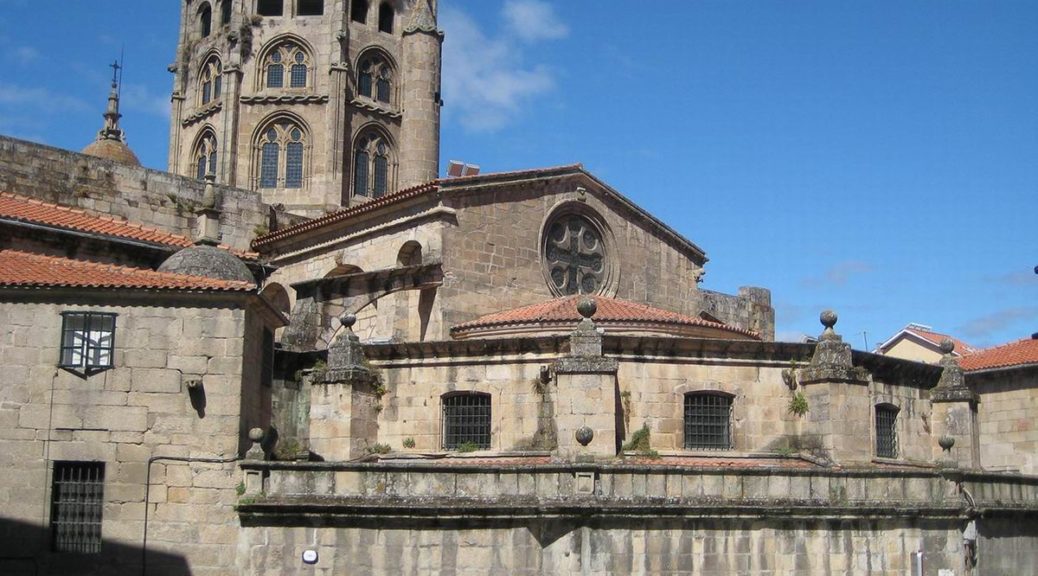ROUTE OURENSE (circular)
FRIDAY, MAY 16
In this stage we will be dedicated to know the two faces of Ourense. On the route through the Monumental Ourense we will visit the Cathedral and all the buildings that invite you to take a walk through the time of a city founded more than 2000 years ago. Already known by the Romans for the great quality of its waters, every day more than three million liters of hot springs arise in the province. On the Miño Thermal Route we travel along a pedestrian path with several thermal facilities located in an environment of great natural beauty.
Difficulty LOW
16.5 kilometers
7 hours
+358 m, -451 m slope

Make your reservation for the GWF Ribeira Sacra Program
-
 GWF Ribeira Sacra 1 Pax Shared Double Room975,00€
GWF Ribeira Sacra 1 Pax Shared Double Room975,00€ -
 GWF Ribeira Sacra 1 Pax Single Room1.235,00€
GWF Ribeira Sacra 1 Pax Single Room1.235,00€ -
 GWF Ribeira Sacra 2 Pax Double Room1.950,00€
GWF Ribeira Sacra 2 Pax Double Room1.950,00€
The urban nucleus of the city of Ourense (Aquae Urentes) was formed as such in the first centuries of our era, during the time of Roman domination. The Romans took advantage of the hot springs of the Burgas and built the bridge to save the Miño River. During the Sueva era, the city becomes the capital of the kingdom. In the following centuries, the continuous sackings of Muslims and Normans originate a period of decline that reaches the year 1071, in which King Sancho II promotes the repopulation of the area.
Throughout the Middle Ages, Ourense becomes an Episcopal Headquarters, settling in the city a large number of religious orders that build their temples forming the current urban structure around the Cathedral and the Plaza Mayor, where the main markets took place, highlighting trade of cereal, oil and the wines made by the monks.
The construction, in 1860, of the Villacastín-Vigo national highway and the new railway lines causes a period of growth of the city and the urban area, building a new bridge and new neighborhoods around it. In the first decades of the twentieth century, its historic center witnesses a great cultural and political movement led by Xeración Nós, highlighting the figures of Otero Pedrayo and Vicente Risco.
Currently, Ourense continues to maintain its importance as an industrial and commercial center of the interior of Galicia.
We begin our route in the Park of San Lázaro, center of the current Ourense around which all the commercial activity of the city takes place. In ancient times it was separated from the city center and there was a small Lazaret hospital, in addition to being the venue for busy fairs. In the center, we can see the 16th-century baroque fountain from the Oseira monastery and several sculptures with typical characters of the city.
On one side of the square is the Church of the Franciscans, which was built in the fourteenth century at the top of the city and subsequently moved to this place in 1929. On the facade, the rosette of the upper body and the lower one stands out two buttresses that delimit a triple archivolt. The ogival-style cloister has 63 pointed arches on twin columns, whose Romanesque capitals have the most varied shapes
We continue along the commercial street of Santo Domingo towards the city center. The community of dominicos began in the mid-17th century the construction of the Church of Santo Domingo, in the Renaissance style, which was not completed until the 19th century. It has a Latin cross plan with a single longitudinal nave covered with a ribbed vault. The facade, with a cover framed by pilasters on which a circular shield pediment with royal crown is placed. Inside, we can see the Baroque main altar, the work of Castro Canseco, and other altarpieces of interest.
At the crossroads that form the Praza do Ferro (Iron Square), the markets of the old iron makers were held, which sold all kinds of farm tools and implements under the arcades. In the center of the square we can see a beautiful fountain from the Monastery of San Esteban de Ribas de Sil. Surrounding the square, the traditional houses of pajabarro and the Palace of Seisciento, decorated with four shields.
In Praza do Trigo (Wheat Square), in addition to the different cereal markets, it was the place where pottery and silver artisans sold their products. Stresses the Fonte Nova, which replaced one of the eighteenth century, and the House of Temes, the same century.
Thus we arrive at the Ourense Cathedral. Legend has it that, in the sixth century, the Suevo monarch Carriarico had his son sick with leprosy, requesting help from San Martín de Tours that heals him of the disease. In gratitude, he converts to Christianity and orders to build a temple where the Cathedral of San Martín de Ourense is today. Various Muslim incursions in these lands destroyed it, rebuilding between the twelfth and thirteenth centuries, in full swing of Romanesque art. Subsequently, several reforms take it to the current state.
The cathedral has a Latin cross plan with three naves, each one finished in a semicircular apse. The crucero, with only one nave and four sections, is covered with a ribbed vault. The south cover is Romanesque from the 13th century and the north cover, also Romanesque, stands out for the statues that make columns. The beautiful dome, in Gothic-Renaissance style, was added in the fifteenth century by Rodrigo de Badajoz, and the San Martin Towers and the Clock Tower in the sixteenth century. The upper part of the facade still retains the battlements, which remind us of its defensive mission.
Accessing through the main door we find the Portico of Paradise, which closely resembles the Portico de la Gloria of the Cathedral of Santiago, with the representation of the elders of the Apocalypse with their musical instruments in the central archivolt. The set retains part of its polychromy and is flanked by two baroque altars. Already, in the interior, the Main Altar is a jewel of the architect Cornelius of Holland, of principles of Century XVI. The Renaissance choir stalls, completed at the end of that century by Juan de Angés and Diego de Solís, complete the set.
In the Chapel of the Holy Christ we can see the image of the Christ so revered in the city, which was brought by Bishop Pérez Mariño in the early fourteenth century. The work is of great realism, the signs of martyrdom being clearly appreciated. There are people who say that his hair grows and even that they have seen him cry. In addition, we can visit the tomb of Bishop Pérez Mariño and other chapels.
Finally, we will visit the Cathedral Museum, located in the Claustra Nova, Gothic style cloister and ribbed vault. There we can see the Treasure of San Rosendo, composed of several chess pieces built in glass, from the 10th century, and a processional cross by Enrique de Arce among other works of sacred art.
We leave the Cathedral and continue on our way through the streets of Ourense. Very close to the Cathedral, the Eironciño dos Cabaleiros was the neighborhood of the aristocratic classes of the city. On one of its sides, we see Maria Andrea’s house, with a wooden balcony from the 16th century. The building hosted several workers’ associations, schools and newspapers. In the tavern El Volter met the intellectuals and artists of Ourense of the time. The architectural complex is complemented by a beautiful “cruceiro”.
In the center of the old town we find the Church of Santa Eufemia. Built by the Jesuits in 1653, the confiscation of Mendizábal in 1776 caused it to pass at the hands of the Ourense miter. Various later additions between the eighteenth and nineteenth centuries, gave it its current appearance.
With a Latin cross plan with three longitudinal and two lateral naves, it stands out for its large volume, very typical of the Baroque idea. The facade, of clearly curved elements that make its narrowness greater, was built by Placido Iglesias and is composed of two column bodies that frame the niche. In the High Altar is the image of the Christ of Hope, made of polychrome wood, made by José Ferreiro in the 18th century
Next to it, the Pazo Oca Valladares was built by maestro Antonio Díaz in the 16th century. On the facade, in Gothic style, we can see five coats of arms of various noble families of the time. From the mid-nineteenth century until today it is the headquarters of the Liceo Recreo de Artesanos de Ourense, one of the oldest cultural societies in the country.
From here we go to Main Square (Praza Maior), the main social center and commercial engine of the city during the centuries under its arcades. The Concello presides over the complex, built at the end of the 19th century, after the previous buildings were demolished. Highlights its facade, classic style.
The Church of Santa María Madre is located on the side of the Main Square. Possibly, this location is that of the first Cathedral of San Martín de Tours, ordered to be built by the Suevo King Carriarico in the sixth century. The various Muslim invasions of later centuries would have destroyed this primitive temple. In 1084, Bishop Ederonio ordered the construction of the Church of Santa María Madre, in Romanesque style. During that time, and due to the various reforms of the Cathedral, he had to replace it several times.
The current temple is the result of the total reconstruction carried out in 1722 by Bishop Marcelino Siuri, which caused the disappearance of that Romanesque jewel. The current one is in the Baroque style with a Latin cross plan, conserving the original part of the interior bodies and the capitals and the columns of the facade. The access stairs from the Main Square enhance this three-body facade. The two lower ones are simple, contrasting with the upper one, profusely decorated and flanked by the bell towers.
Inside, the altarpiece of the Main Altar, with two bodies, was made of non-polychrome wood in the middle of the 18th century. In the center is the baroque image of Santa María Madre.
The Archaeological Museum of Ourense has been declared a Historic-Artistic Monument since 1931, being one of the most important nationwide, not only for its collections, but also for the building’s own history. In the excavations carried out various ashlars have appeared, so we deduce that it was already Roman Praetorium in the origins of the city. Later, in the sixth century, it was the palace of the Suevian kings who ruled these lands.
Already from 1071 to 1952, it became the seat of the Bishopric, beginning to build the current Romanesque building in 1131, at the time of Bishop Don Diego de Velasco. In our walk through the enclosure we will find remains of its different stages of construction, in addition to others of great archaeological value. From the Paleolithic to the 18th century, through the “mamoas” of the Bronze Age, the Castilian and Roman-Galician culture, its rooms will help us understand our origins a little more. The Museum also includes a section of Arts, which stands out for its Renaissance works, and other units dedicated to temporary exhibitions.
We continue our route and arrive at the Hot Springs of As Burgas that are, without a doubt, the main reason for the existence of the city of Ourense. Declared ‘Artistic historical complex’ in 1975, around these springs, the city was growing at the time of Roman domination.
The legend says that these springs are born under the chapel of the Holy Christ, in the Cathedral. The Burga de Abajo, built in the mid-19th century, is the one with the most flow. It consists of three bodies, each with its pipe, on which we contemplate the shield of the city. With less water level is the Burga de Arriba, from the 17th century, with two pipes and simple structure. The set is completed by the replica of 4 Roman aras, a small thermal water pond and two sculptures: “The house of the cloud” and “Calpurnia Abana”, dedicated to the nymph Calpurnia.
The waters are fluorinated and hyperthermal silicates, applicable to various types of dermopathies. The water temperature is 70 degrees Celsius and the flow rate is 300 liters per minute.
The Ponte Vella (Old Bridge) was built during Roman rule, during the time of Emperor Trajan (1st-2nd century AD). From the construction period there are only a few blocks of the bases. In 1228 it was rebuilt by mandate of Bishop Don Lorenzo, with the ramps and the central arch pointed. In 1667, Melchor de Velasco, providing the magnitude it has today, retaining 7 arches of the initial structure.
In the 19th century the defensive tower was demolished. The bridge is 370 meters long and 5 meters wide, with an impressive central arch 43 meters wide that rises 38 meters above the level of the Miño, making it one of the main hallmarks of the city.
In San Lázaro Park we finish this route through the Monumental Ourense, not without recommending that Ourense is a perfect city to get out of wines. In the small space that delimits the old area, we can start in one of its bars, with rich tapas watered by the famous wines of the area. After that, we will taste a delicious coffee in one of its classic coffee shops, heirs of the old literary gatherings, and that schedule cultural activities all year round. At night, the entire old town becomes a coming and going of people, which we will use to visit one of the pubs that give this city its atmosphere.
OURENSE THERMAL ROUTE
On this route we will cross the banks of the Miño River, knowing all its hot springs, some private and others for public use. We cross the Ponte Vello to cross the Ribeirinho Park along a path always at the edge of the river.
The first that we find is Pozas da Chavasqueira, which are a set of small natural stone pools free of charge and surrounded by green areas. They are also called Caldas do Bispo, in reference to Cardinal Quevedo who had them conditioned in the 19th century. The waters, which arise at a temperature of about 40º, have a weak mineralization, lithine, alkaline, sulphide and silicate. They are especially indicated for skin and musculoskeletal disorders. The pools have a changing room for use by bathers.
Next to them, the private installation Termas da Chavasqueira simulates a Japanese bathhouse, with a calm atmosphere and Zen inspiration. In addition to a complete thermal circuit, it offers various types of treatments. The waters are about 60º and are of medium mineralization.
We continue on our way and pass by the Campo da Feira, in which the fair is held 2 days a month. Here, in addition to selling all kinds of products, the Oureans like to go to eat the octopus, a product of the sea that in this province of the interior they prepare like nobody else. Later, we find a perfect picnic area next to Miño River.
We continue on our way and arrive at the Tinteiro Spring, located in a wonderful viewpoint over the river. The waters have a temperature of 43º and are of weak mineralization, bicarbonated, sodium and fluorinated. They are especially indicated for skin conditions.
From here we have to walk 2 kilometers along the edge of the river until we reach the following thermal station: the Muiño da Veiga, set of 5 swimming pools with waters around 40º, although some arise at very high temperatures of 65º. The waters are of weak mineralization and alkaline: bicarbonated-sodium, fluorinated and silicated.
We continue walking to reach the Termas de Outariz thermal station, which is inspired by the spa culture of Japan and has 11 outdoor and 4 indoor hot springs. In its 2 complete thermal circuits (Zen and Celtic) we can relax or eliminate these tensions from day to day. It also has a massage service, beauty treatments and a bar for a drink after the bath.
Shortly after is the largest thermal area in the city. The Pozas de Outariz and Burga de Canedo are a set of hot and cold pools located in a landscaped environment on this bank of the Miño River. The waters, which emerge in some cases at 60 ° C, are weakly mineralized, alkaline, fluorinated and silicated. They are indicated for skin and musculoskeletal disorders.
During the high season, the Thermas Train leaves from Praia Maior that takes you on a pleasant walk through all these thermal stations on the banks of the Miño River. If you want to make the circular route and return along the south bank of the Miño River, you will have to walk a little less than 5 kilometers to the San Lázaro Park.
In the middle, on the Paseo das Ninfas, there is the Fonte de Reza, which leaves at a temperature of 31ºC. They are of weak mineralization, alkaline and fluorinated, being indicated for skin conditions and colds.
We arrive at the San Lázaro Park, the base point of these routes through the Monumental Ourense and the Thermal Ourense that has helped us to learn more about its history and enjoy its famous hot springs.
Route Planning
| Km Stage | Point | Height (m) | Km Total |
| 0,0 | Santomé | 233 | 83,0 |
| 0,1 | Castro de Santomé | 225 | 83,1 |
| 0,1 | Roman Village | 225 | 83,1 |
| 0,9 | Camino Real | 161 | 83,9 |
| 2,1 | Lonia River Footbridge | 111 | 85,1 |
| 2,4 | Mende Bridge | 105 | 85,4 |
| 2,8 | Lonia Park | 107 | 85,8 |
| 4,2 | Old Bridge (Ponte Vella) | 93 | 87,2 |
| 4,4 | Ribeirinho Park | 103 | 87,4 |
| 4,8 | Millennium Bridge | 102 | 87,8 |
| 5,1 | Chavasqueira Pools | 97 | 88,1 |
| 5,2 | Chavasqueira Thermal Station | 97 | 88,2 |
| 5,3 | Campo da Feira | 96 | 88,3 |
| 5,6 | Picnic Area | 97 | 88,6 |
| 5,9 | Tinteiro Hot Springs | 94 | 88,9 |
| 8,2 | Muiño da Veiga Pools | 92 | 91,2 |
| 8,6 | Outariz Thermal Station | 100 | 91,6 |
| 9,1 | Outariz footbridge | 87 | 92,1 |
| 13,3 | Barbantiño River | 102 | 96,3 |
| 13,8 | Tourist Office | 106 | 96,8 |
| 13,8 | Capel of Remedios | 106 | 96,8 |
| 15,0 | Alameda do Concello | 126 | 98,0 |
| 15,2 | Correos | 119 | 98,2 |
| 15,2 | Bishopric of Ourense | 114 | 98,2 |
| 15,2 | Municipal Market | 129 | 98,2 |
| 15,3 | As Burgas Thermal Station | 133 | 98,3 |
| 15,4 | Provincial Archaeological Museum | 135 | 98,4 |
| 15,5 | Main Square | 133 | 98,5 |
| 15,5 | Town Hall | 135 | 98,5 |
| 15,6 | Church of Santa María la Mayor | 139 | 98,6 |
| 15,6 | Magdalena Square | 142 | 98,6 |
| 15,7 | Trigo Square | 147 | 98,7 |
| 15,7 | Suaves Square | 146 | 98,7 |
| 15,8 | Cathedral of Ourense | 146 | 98,8 |
| 15,9 | Church of Santa Eufemia | 138 | 98,9 |
| 16,0 | Padre Feijoo Garden | 132 | 99,0 |
| 16,0 | Tourist Office | 132 | 99,0 |
| 16,2 | Ferro Square | 144 | 99,2 |
| 16,2 | Lepanto Street | 144 | 99,2 |
| 16,5 | San Lázaro Park | 141 | 99,5 |


